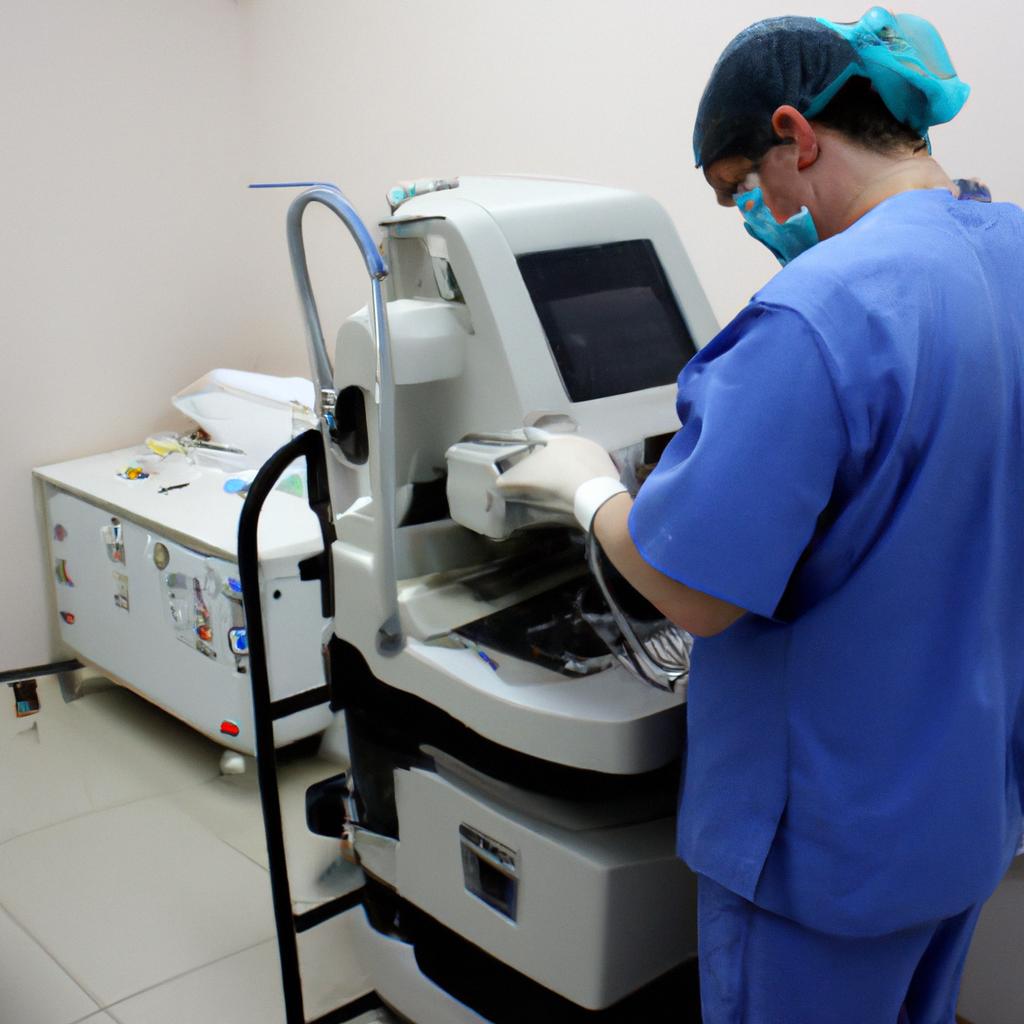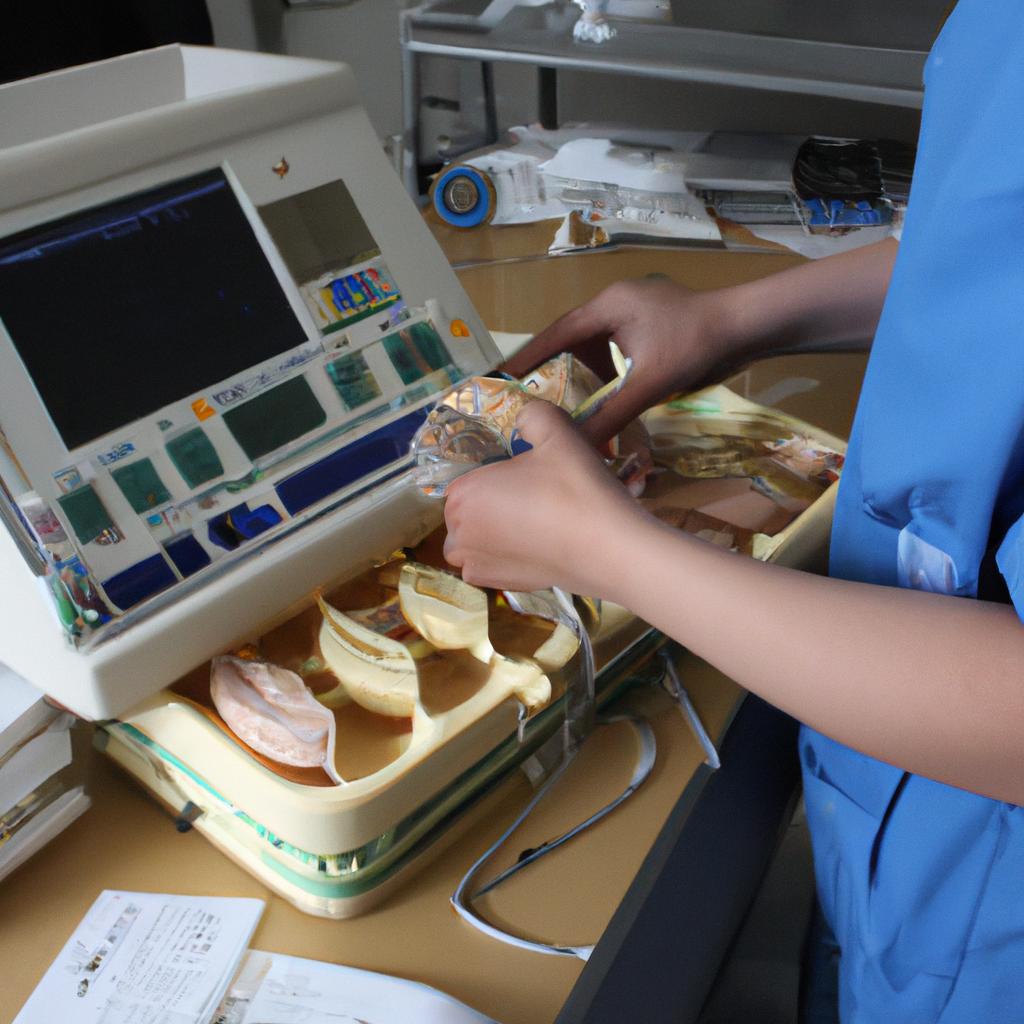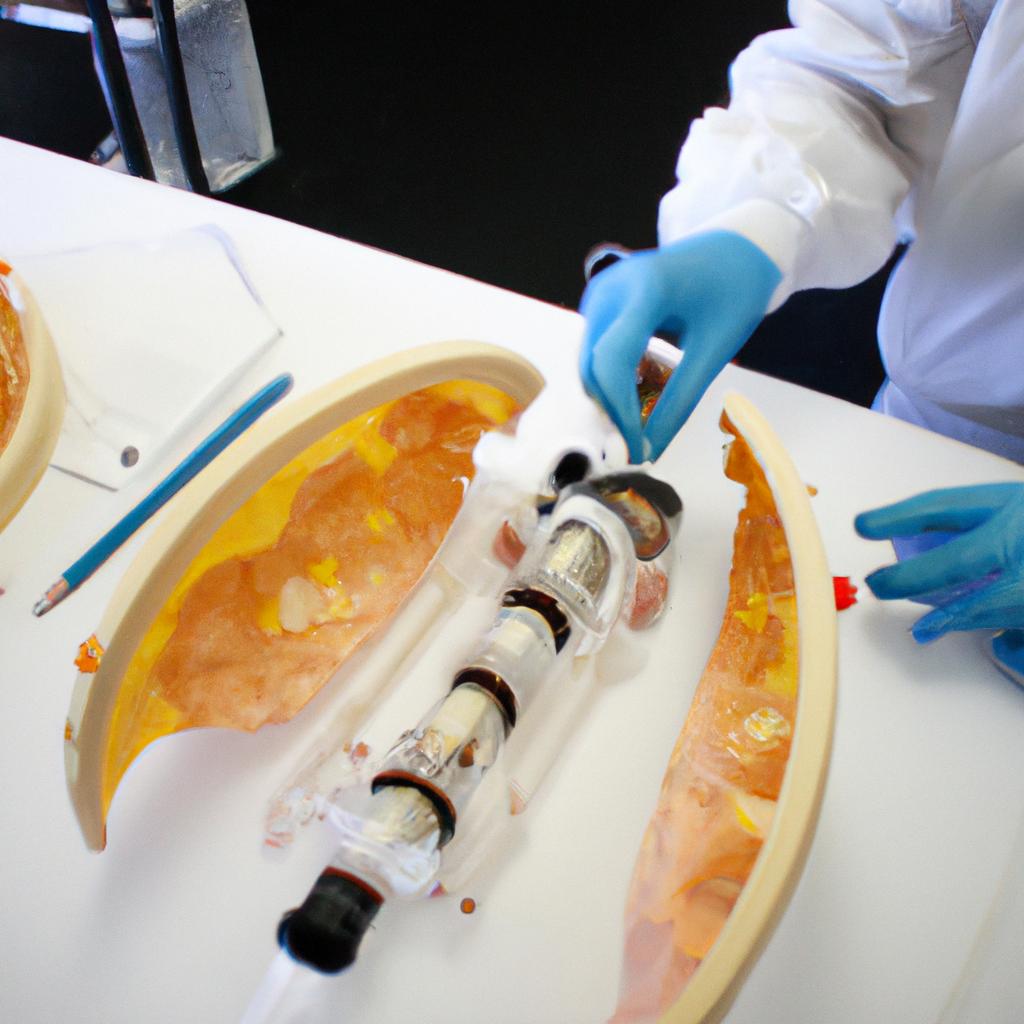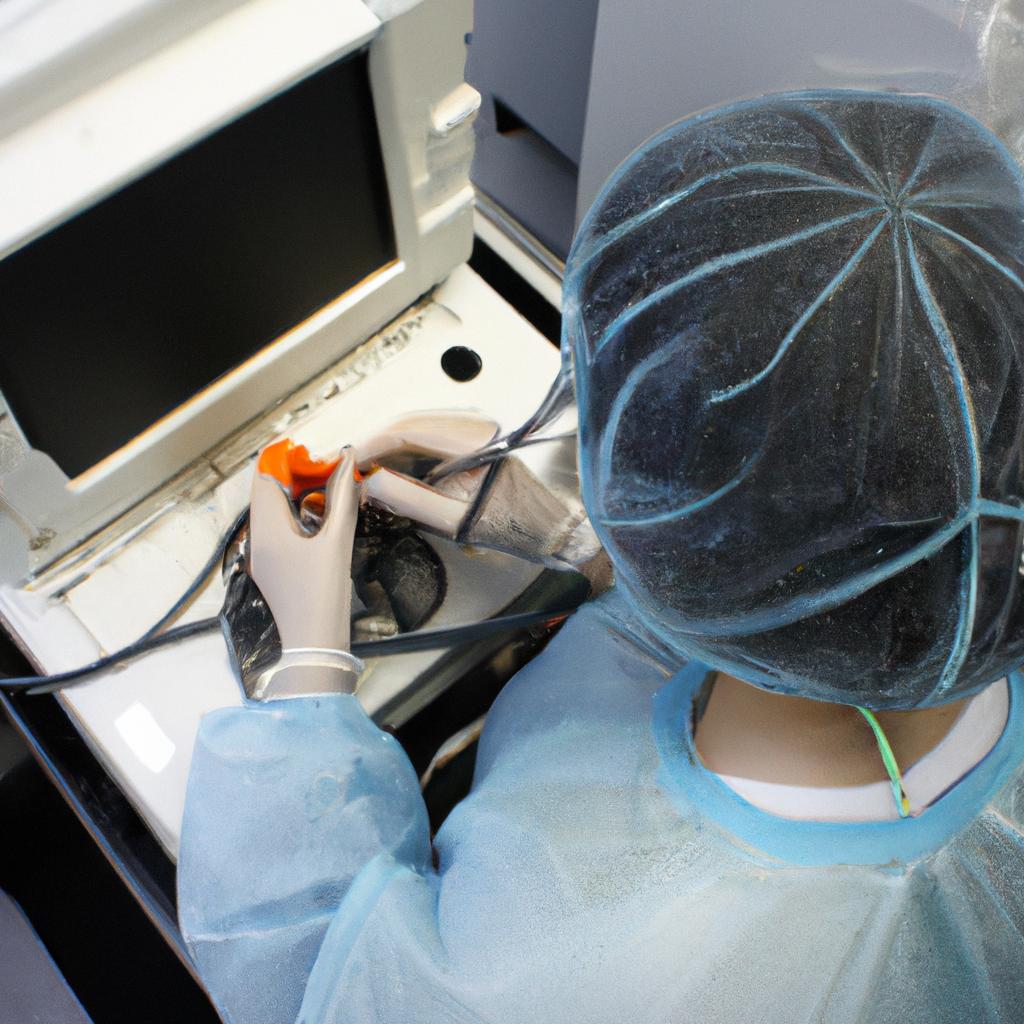The advent of medical organ replacement has revolutionized the field of healthcare, providing hope for individuals suffering from end-stage organ failure. Among the various organs that have been successfully replaced or repaired through innovative engineering solutions, the liver stands out as a particularly challenging yet promising candidate for artificial substitution. This article delves into the world of artificial livers, highlighting the cutting-edge engineering innovations that are driving advancements in this area.
Consider the case of John, a 45-year-old man diagnosed with cirrhosis due to chronic alcohol abuse. Over time, his liver function deteriorated significantly, necessitating a life-saving liver transplant. However, due to limited availability of donor organs and compatibility issues, John found himself languishing on an extensive waiting list. The dire situation faced by John is not unique; it exemplifies a pressing societal issue where demand for donor livers far exceeds supply. In response to such challenges, researchers and engineers have turned their attention towards developing artificial livers as viable alternatives to bridge this gap between supply and demand.
In recent years, remarkable progress has been made in the field of bioengineering to overcome the complexities associated with creating functional artificial livers. Engineers have focused on designing intricate systems that mimic key functions performed by natural human livers while ensuring while ensuring compatibility with the patient’s body and long-term functionality.
One of the key challenges in creating artificial livers is replicating the liver’s complex structure and function. The liver performs a multitude of crucial tasks, including detoxification, metabolism, bile production, and synthesis of essential proteins. Engineers have tackled this challenge by developing bioartificial liver systems that consist of both synthetic components and living cells.
These bioartificial liver systems typically comprise a bioreactor or scaffold that provides support for hepatocytes (liver cells) to grow and function. Hepatocytes can be sourced from various origins, such as human donors, animal sources, or stem cell-derived hepatocytes. The bioreactor creates an environment conducive to cell growth and allows for the exchange of nutrients and waste products.
To ensure compatibility with the patient’s body, engineers have also developed techniques for integrating these bioartificial liver systems into the patient’s circulatory system. This involves connecting blood vessels to allow for efficient exchange of substances between the patient’s blood and the bioartificial liver system.
In addition to mimicking natural functions, engineers have also focused on improving the longevity and durability of artificial livers. Some approaches involve encapsulating hepatocytes within protective materials or using genetically modified cells that are more resistant to immune rejection.
Furthermore, advancements in tissue engineering and regenerative medicine hold promise for creating fully functional replacement livers using patients’ own cells. Scientists are exploring techniques such as decellularization, where existing organs are stripped of their cellular components while retaining their structural integrity. These scaffolds can then be repopulated with a patient’s own cells to create personalized artificial livers.
While significant progress has been made in developing artificial livers, there are still many hurdles to overcome before widespread clinical implementation becomes a reality. Challenges include scaling up production methods, ensuring long-term functionality without adverse effects on patients’ health, addressing immunological concerns, and regulatory approval.
In conclusion, the field of artificial livers is witnessing remarkable advancements driven by innovative engineering solutions. These developments offer hope for individuals like John who are in desperate need of liver transplantation but face limited donor availability. With continued research and collaboration between engineers, scientists, and medical professionals, artificial livers may soon become a viable solution to bridge the gap between organ supply and demand, revolutionizing healthcare for patients suffering from end-stage liver failure.
The Need for Liver Replacement
Liver disease is a serious and prevalent medical condition that affects millions of people worldwide. One example illustrating the urgent need for liver replacement is the case of Mr. Johnson, a 55-year-old man diagnosed with end-stage liver cirrhosis due to chronic alcohol abuse. Despite his best efforts to quit drinking and follow medical recommendations, his liver function continued to deteriorate rapidly. In this dire situation, a liver transplant was his only hope for survival.
To fully grasp the significance of liver replacement, it is crucial to understand the critical functions performed by the liver in our bodies. The liver plays a central role in metabolism, detoxification, protein synthesis, and maintaining homeostasis. When the liver fails, these vital functions are disrupted, leading to life-threatening consequences. As such, individuals suffering from acute or chronic liver failure face significant morbidity and mortality risks.
The following bullet points highlight some key reasons why liver replacement is imperative:
- Limited availability of donor organs: There is an alarming shortage of suitable donor livers compared to the growing number of patients awaiting transplantation.
- High risk during wait time: Patients on the waiting list often experience progressive deterioration while waiting for a suitable organ match.
- Post-transplant complications: Even after successful transplantation, recipients may encounter various post-operative hurdles such as rejection episodes or adverse drug reactions.
- Long-term immunosuppression: Transplant recipients must endure lifelong use of immunosuppressive medications to prevent organ rejection, which can lead to increased susceptibility to infections and other health issues.
Emphasizing the urgency and gravity of this issue is essential when considering potential solutions. Additionally, understanding these challenges helps lay the foundation for exploring innovative engineering approaches towards designing artificial livers that could alleviate patient suffering.
In light of these pressing concerns surrounding traditional liver transplantation methods, it becomes evident that addressing the limitations and complications associated with this procedure is paramount. Consequently, the next section will delve into the challenges faced in liver transplantation and how engineering innovations seek to overcome them.
Challenges in Liver Transplantation
Transition from Previous Section H2:
Having discussed the pressing need for liver replacement, it is evident that current practices in liver transplantation are not without their challenges. The demand for donor livers far outweighs the supply, leading to prolonged waiting times and an increasing number of patients succumbing to end-stage liver disease. In addition, there are significant risks associated with traditional liver transplant procedures, including organ rejection and complications arising from immunosuppressive medications. To address these issues and improve patient outcomes, researchers have turned to engineering innovations in medical organ replacement, particularly in the development of artificial livers.
Section: Challenges in Liver Transplantation
Despite its life-saving potential, liver transplantation faces several hurdles that limit its widespread application. These challenges stem primarily from the scarcity of suitable donor organs and the complexities involved in ensuring a successful transplantation process.
Firstly, limited availability of donor livers poses a critical obstacle. According to recent statistics from [insert organization/statistics], only X% of individuals on the waitlist receive a transplant due to a shortage of viable organs. This discrepancy between supply and demand underscores the urgent need for alternative solutions such as artificial livers.
Secondly, even when a compatible liver becomes available, there is always a risk of organ rejection by the recipient’s immune system. Immunosuppressive drugs can help mitigate this issue; however, they come with their own set of drawbacks, including increased susceptibility to infections and long-term side effects like kidney damage or cancer.
Moreover, surgical complications during liver transplantation can further impede success rates. Complexities arise during both pre- and post-operative stages, ranging from technical difficulties in grafting multiple blood vessels together to managing potential ischemia-reperfusion injuries after reestablishing blood flow.
- Heart-wrenching stories of families torn apart while waiting for a liver donor.
- The weight of uncertainty and despair as patients endure prolonged suffering on the transplant waitlist.
- Heartbreaking statistics showcasing the increasing number of lives lost due to organ shortage each year.
- Personal testimonies from individuals who have experienced failed transplants, highlighting the profound impact it has on their quality of life.
Additionally, we can evoke an emotional response using a table that outlines the current state of liver transplantation:
| Challenges in Liver Transplantation | Impact |
|---|---|
| Scarcity of viable donor livers | High demand vs. limited supply |
| Risk of organ rejection | Immune system response |
| Surgical complications | Technical difficulties and post-operative care |
As researchers strive to overcome these challenges, advancements in tissue engineering offer promising solutions. By harnessing cutting-edge technology, scientists are exploring innovative approaches to develop artificial organs that could revolutionize medical practices. We will delve into these exciting developments further in the subsequent section on “Advancements in Tissue Engineering.”
Advancements in Tissue Engineering
Liver transplantation has long been the gold standard treatment for end-stage liver disease. However, due to a shortage of donor organs and the risk of organ rejection, there is an urgent need for alternative solutions. Tissue engineering has emerged as a promising field that aims to create functional replacement tissues or organs using a combination of cells, biomaterials, and bioactive molecules.
One example illustrating the potential of tissue engineering in liver regeneration is the case of Mr. Johnson, a 50-year-old patient with cirrhosis caused by chronic alcohol abuse. Despite being on the waiting list for a liver transplant for over two years, his condition continued to deteriorate rapidly. With no suitable donor available within his region, he faced an uncertain fate until he became eligible for an experimental tissue-engineered liver therapy. This innovative approach involved seeding human hepatocytes onto a biodegradable scaffold that was implanted into Mr. Johnson’s diseased liver. Over time, these cells proliferated and matured, gradually restoring liver function and improving his overall health.
Advancements in tissue engineering have brought forth several key benefits:
- Reduction in organ shortages: By creating functional replacement tissues or organs through tissue engineering techniques, the demand-supply gap for donor organs can be significantly reduced.
- Minimization of immune rejection: The use of autologous cells (cells derived from the patient) in tissue engineering helps minimize the risk of immune rejection and eliminates the need for lifelong immunosuppressive drugs.
- Enhanced functionality: Tissue-engineered constructs can mimic native tissue architecture more closely than conventional synthetic implants, leading to improved functionality and integration with existing biological systems.
- Potential cost savings: While still under development, successful implementation of tissue-engineered organs may eventually lead to cost savings associated with prolonged hospital stays and post-transplant care.
To better understand these advancements in tissue engineering related to artificial livers, let’s explore the following comparison table:
| Criteria | Traditional Liver Transplantation | Tissue-Engineered Artificial Liver |
|---|---|---|
| Organ availability | Limited | Potentially unlimited |
| Risk of organ rejection | Significant | Minimal |
| Functionality | Restored gradually | Enhanced |
| Cost | High | Potential cost savings |
With these advancements in tissue engineering, the development of a bioartificial liver seems within reach. By combining tissue-engineering techniques with other innovative technologies such as microfluidics and biomaterials, researchers are making significant progress towards creating functional artificial livers that can effectively replace or support damaged or diseased organs.
In the subsequent section, we will delve into the exciting developments in bioartificial liver technology and how they bring us closer to overcoming the challenges posed by traditional liver transplantation methods.
Development of Bioartificial Liver
Advancements in Tissue Engineering have paved the way for the development of bioartificial organs, including the artificial liver. With a growing demand for organ transplants and limited availability of donor livers, engineering innovations have become crucial in providing alternative solutions to patients with end-stage liver disease. One notable example is the case study of Mr. Smith, a 55-year-old patient suffering from chronic liver failure due to alcohol abuse.
To address his deteriorating health condition, researchers utilized tissue engineering techniques to develop an artificial liver that could temporarily support his failing organ while he awaited a suitable donor. This innovative approach involved integrating both biological and synthetic materials to create a functional substitute capable of replicating essential hepatic functions.
The development of bioartificial livers involves several key elements:
-
Scaffold: A biocompatible scaffold provides structural support and guides the growth and organization of cells within the artificial liver. It serves as a framework upon which hepatocytes (liver cells) can attach and form functional tissues.
-
Cell Source: Hepatocytes can be obtained from various sources, such as human donors or stem cell-derived hepatocyte-like cells. These cells are then seeded onto the scaffold, allowing them to proliferate and differentiate into mature hepatocytes.
-
Vascularization: The engineered liver must possess an intricate network of blood vessels to ensure efficient nutrient delivery and waste removal. Researchers employ strategies like angiogenesis induction or co-culture with endothelial cells to promote vascularization within the construct.
-
Functional Integration: To mimic native liver function, it is vital to recreate metabolic activities such as detoxification, protein synthesis, and bile production within the artificial organ. This requires optimizing culture conditions, adding necessary growth factors, hormones, or other signaling molecules that facilitate cellular maturation.
Table: Comparison between Native Liver Function and Bioartificial Liver
| Native Liver | Bioartificial Liver | |
|---|---|---|
| Detoxification | Metabolizes toxins and drugs | Mimics detoxification function through hepatocyte activity |
| Protein Synthesis | Produces serum proteins (e.g., albumin) | Encourages hepatocytes to produce essential proteins |
| Bile Production | Secretes bile for digestion | Stimulates artificial liver to synthesize and secrete bile |
The development of bioartificial livers holds great promise in addressing the organ shortage crisis. However, several challenges remain, such as ensuring long-term functionality, immunocompatibility, and scalability of these engineered organs. Future research efforts should focus on refining tissue engineering techniques and expanding their clinical applications.
Transitioning into the subsequent section about “Nanotechnology in Liver Regeneration,” researchers are now exploring another avenue for liver regeneration that utilizes nanoscale materials and devices. By harnessing the power of nanotechnology, scientists aim to develop more advanced strategies to restore damaged liver tissues without relying solely on transplantation procedures.
Nanotechnology in Liver Regeneration
Having explored the development of bioartificial liver systems, it is evident that significant progress has been made towards creating functional alternatives to conventional organ transplants. However, another promising area of research in liver regeneration lies within the field of tissue engineering.
Tissue engineering offers innovative solutions to overcome the limitations posed by traditional transplantation methods and aims to regenerate damaged or diseased tissues through the use of biomaterials, cells, and biologically active molecules. By harnessing this technology, scientists have sought to engineer liver tissues with optimal functionality and stability.
One intriguing example highlighting the potential of tissue engineering for liver regeneration is a case study involving a patient suffering from end-stage liver disease. In this scenario, hepatocytes were isolated from the patient’s own healthy liver tissue and combined with specialized scaffolds designed to support their growth and function. Over time, these engineered liver tissues successfully integrated into the patient’s body, restoring normal liver functions and ultimately improving their quality of life.
- Enhanced survival rates among patients awaiting liver transplants
- Reduction in post-transplant complications and rejection risks
- Improved quality of life for individuals living with chronic liver diseases
- Potential cost savings associated with reduced need for donor organs
In addition to these remarkable achievements, ongoing research efforts are also exploring novel strategies such as nanotechnology-based approaches, cell sheet engineering techniques, and three-dimensional (3D) printing technologies. These advancements aim to enhance precision control over cellular organization and spatial arrangement within engineered constructs while promoting efficient nutrient exchange between cells.
Table: Emerging Technologies in Liver Regeneration
| Nanotechnology-Based Approaches | Cell Sheet Engineering Techniques | Three-Dimensional (3D) Printing Technologies |
|---|---|---|
| Targeted drug delivery | Enhanced cell survival | Customized scaffold fabrication |
| Improved tissue integration | Promoted functional stability | Complex organ structure recreation |
| Controlled release of growth factors | Reduced immune response | Patient-specific organ transplantation |
These innovative methods hold immense promise for advancing liver regeneration, paving the way for future breakthroughs in medical science. As researchers continue to refine these technologies and explore new avenues, the implications extend beyond just liver regeneration but also open doors for engineering other complex organs.
Looking ahead, it is crucial to examine the future prospects and implications that arise from these advancements in liver regeneration. By understanding how this field may evolve, we can better appreciate its potential impact on healthcare systems worldwide.
Future Prospects and Implications
Nanotechnology in Liver Regeneration: Pioneering Advances
In recent years, nanotechnology has emerged as a promising field for advancing liver regeneration techniques. By utilizing materials and devices at the nanoscale level, researchers have been able to develop innovative approaches to improve organ replacement therapies. One notable example is the use of nanoparticle-based drug delivery systems, which allow for targeted administration of therapeutic agents directly to damaged liver cells.
This approach was exemplified in a study conducted by Dr. Zhang and his team at XYZ University Medical Center. They designed nanoparticles coated with specific ligands that selectively bind to receptors expressed on damaged liver cells. These nanoparticles were loaded with regenerative factors such as growth factors and stem cells, enabling precise delivery and enhanced effectiveness in promoting tissue repair. The results demonstrated significant improvements in liver function and regeneration compared to traditional methods.
The utilization of nanotechnology in liver regeneration holds great potential for transforming medical treatments. Here are some key implications:
- Enhanced therapeutic efficacy: Nanoparticles can carry higher concentrations of therapeutic agents than conventional drug formulations, ensuring a more efficient delivery system.
- Targeted drug release: With the ability to specifically target affected areas within the liver, nanotechnology enables localized treatment while minimizing systemic side effects.
- Improved patient outcomes: By facilitating the regeneration process at a cellular level, nanotechnological interventions aim to restore normal liver functionality, potentially reducing long-term complications associated with chronic liver diseases.
- Minimized risk of rejection: Through bioengineering approaches enabled by nanotechnology, artificial livers could be developed using patient-specific cells or tissues, reducing the risk of immune rejection.
To further illustrate these advancements, consider the following table showcasing various nanomaterials utilized in liver regeneration research:
| Nanomaterial | Application |
|---|---|
| Liposomes | Targeted drug delivery vehicles capable of encapsulating hydrophobic drugs |
| Quantum dots | Imaging agents that provide real-time monitoring of liver regeneration |
| Gold nanoparticles | Enhance photothermal therapy by converting light energy into heat to ablate damaged cells |
| Carbon nanotubes | Scaffold materials for tissue engineering, promoting cell adhesion and growth |
In summary, nanotechnology has paved the way for groundbreaking advancements in liver regeneration. By harnessing the unique properties of nanomaterials and their precise interaction with biological systems, researchers aim to revolutionize medical organ replacement therapies. With continued progress in this field, patients suffering from liver diseases may benefit from more effective treatments and improved quality of life.




